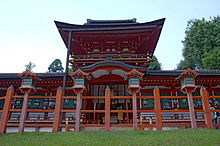| Kasuga-taisha 春日大社 | |
|---|---|
 The middle gate and hall | |
| Religion | |
| Affiliation | Shinto |
| Deity | |
| Festival | Kasuga-no-matsuri (Kasuga-sai: 春日祭) (13 March) |
| Type | Twenty-Two Shrines Chokusaisha Beppyo jinja, Shikinaisya Former kanpeitaisha |
| Location | |
| Location | 160 Kasugano-chō, Nara-shi, Nara-ken |
| Geographic coordinates | 34°40′53″N 135°50′54″E / 34.68139°N 135.84833°E |
| Architecture | |
| Style | Kasuga-zukuri |
| Date established | 768 |
| Website | |
| www | |
| Part of a series on |
| Shinto |
|---|
 |
Kasuga-taisha (春日大社) is a Shinto shrine in Nara, Nara Prefecture, Japan.[1] It is the shrine of the Fujiwara family, established in 768 CE and rebuilt several times over the centuries. The interior is famous for its many bronze lanterns, as well as the many stone lanterns that lead up the shrine.
The architectural style Kasuga-zukuri takes its name from Kasuga Shrine's honden (sanctuary). The Torii at Kasuga-taisha is one of the oldest in Shinto and helped influence the style of Torii seen across much of Japan. Kasuga Shrine, and the Kasugayama Primeval Forest near it, are registered as a UNESCO World Heritage Site as part of the "Historic Monuments of Ancient Nara".
The path to Kasuga Shrine passes through a deer park. In the park, deer are able to roam freely and are believed to be sacred messengers of the Shinto gods that inhabit the shrine and surrounding mountainous terrain. Kasuga Shrine and the deer have been featured in several paintings and works of art of the Nambokucho Period.[2] Over three thousand stone lanterns line the way. The Man'yo Botanical Garden is adjacent to the shrine.
- ^ Richard, Ponsonby-Fane. (1964), Visiting Famous Shrines in Japan, pp. 221–251.
- ^ Birmingham Museum of Art (2010). Birmingham Museum of Art : guide to the collection. [Birmingham, Ala]: Birmingham Museum of Art. p. 46. ISBN 978-1-904832-77-5.
